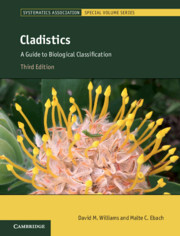Book contents
- Cladistics
- The Systematics Association Special Volume Series
- Cladistics
- Copyright page
- Dedication
- Contents
- Preface
- Acknowledgements
- Introduction: Carving Nature at Its Joints, or Why Birds Are Not Dinosaurs and Men Are Not Apes
- Part I The Interrelationships of Organisms
- Part II Systematics: Exposing Myths
- Part III The Cladistic Programme
- Part IV How to Study Classification
- Part V Beyond Classification
- Afterword
- Index
- Systematics Association Special Volumes
- References
Part III - The Cladistic Programme
Published online by Cambridge University Press: 20 July 2020
- Cladistics
- The Systematics Association Special Volume Series
- Cladistics
- Copyright page
- Dedication
- Contents
- Preface
- Acknowledgements
- Introduction: Carving Nature at Its Joints, or Why Birds Are Not Dinosaurs and Men Are Not Apes
- Part I The Interrelationships of Organisms
- Part II Systematics: Exposing Myths
- Part III The Cladistic Programme
- Part IV How to Study Classification
- Part V Beyond Classification
- Afterword
- Index
- Systematics Association Special Volumes
- References
- Type
- Chapter
- Information
- CladisticsA Guide to Biological Classification, pp. 149 - 212Publisher: Cambridge University PressPrint publication year: 2020
References
References
References
Reference
References
References
References
Further Reading
We cannot recommend this paper enough. It is the first attempt to define cladistics as a field in its own right and the first to situate it in the context of systematics and taxonomy as opposed to the more specialised field of phylogenetics – although over 40 years old, it has lost none of its stimulating power. A similar version can be found in: Nelson, GJ. & Platnick, NI. 1981. Systematics and Biogeography: Cladistics and Vicariance. Columbia University Press, New York, xi+567 pp, in the section on ‘Classification and General Cladograms’ in Chapter 4: ‘Systematic Results: Classifications’ (p. 305 et seq.).
Also of interest is a series of papers on homology published in the journal Cladistics, which are worth examination, as some of the contributions (Nixon & Carpenter contra Brower & de Pinna) bring out differences of interpretation under the same analytical paradigm (that of Wagner parsimony), relative to our own viewpoint, which has no commitment to any particular methodology. We present the papers below in chronological sequence:
1. Brower, AVZ. 2011. The meaning of ‘‘phenetic’’. Cladistics 28: 113–114.
2. Nixon, KC. & Carpenter, JM. 2011. On homology. Cladistics 28: 160–169.
3. Williams, DM. & Ebach, MC. 2012. Confusing homologs as homologies: A reply to “On homology”. Cladistics 28: 223–224.
4. Nixon, KC. & Carpenter, JM. 2012. More on homology. Cladistics 28: 225–226.
5. Williams, DM. & Ebach, MC. 2012. “Phenetics” and its application. Cladistics 28: 229–230.
6. Brower, AVZ. & de Pinna, MCC. 2012. Homology and errors. Cladistics 28: 529–538.
7. Nixon, KC. & Carpenter, JM. 2012. More on errors. Cladistics 28: 539–544.
8. Platnick, NI. 2013. Less on homology. Cladistics 29: 10–12.
9. Platnick, NI. 2013. Reification, matrices, and the interrelationships of goblin spiders. Zootaxa 3608: 278–280.
10. Ebach, MC. & Williams, DM. 2013. E quindi uscimmo a riveder le stelle. Cladistics 29: 227.

